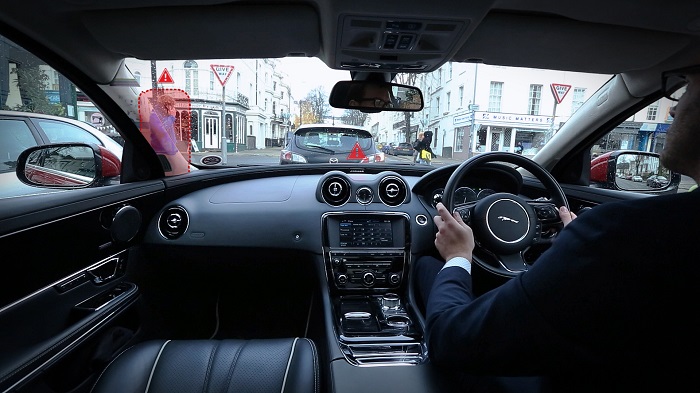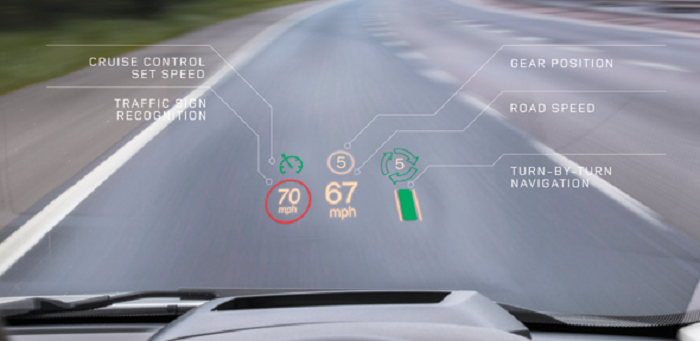For the first time, a car manufacturer has incorporated holographic display technology into its line of vehicles.

Jaguar Land Rover has announced it will formally begin incorporating the technology developed by researchers at Cambridge University. Per the company’s announcement, it will provide drivers with information such as the car’s speed, direction it is travelling, as well as turn-by-turn navigation instructions.

What’s particularly interesting about this technology, referred to as head-up displays or HUD for short, is that the information is not presented in typical two dimensional format; rather, it is projected on to the roadway ahead of the vehicle. This is meant to keep the data informative, and less a distraction.
Per the Cambridge researchers that created the technology, the incorporation of this display marks a milestone step towards cars that provide a fully immersive experience, and can improve safety by monitoring driver behavior.
“We're moving towards a fully immersive driver experience in cars, and we think holographic technology could be a big part of that, by providing important information, or even by encouraging good driver behavior,” said one of the technology's developers, Professor Daping Chu of the University's Department of Engineering, who is also Chairman of the Center for Advanced Photonics and Electronics (CAPE).
Research into the holographic display technology started with Cambridge Professor Bill Crossland in 2001. It was then licensed to and developed by CAPE partner company Alps Electric, and then by Two Trees Photonics Ltd at Milton Keynes, in collaboration with researchers at CAPE.
Early products were designed by Two Trees Photonics and Alps, and manufactured by Alps for Jaguar Land Rover, with it finally becoming an available option on the manufacturer’s vehicles in September 2014.
In terms of its actual functionality, the technology uses laser holographic techniques, which are understood to provide better color, brightness, and contrast than other similar systems, but in a smaller, less heavy package.
Chu points out that the technology is not fully realized yet, and that it could be particularly useful in future models.
“What we really want to see is a fully 3D display which can provide much more information to the driver in a non-intrusive way – this is still a first generation piece of technology,” he said.
Chu added: “There are three main types of information that we could integrate into future holographic head-up displays in the future,” he said. “The first is the type of information that's on today's displays, but potentially we could add other information in a non-intrusive way: for example, if the driver passes a petrol station, perhaps the price of petrol at that station could flash up in the corner – the trick is how to display the most useful information in a way that doesn't distract the driver.
“The next level of information that could be incorporated into holographic HUDs is information about the position of pedestrians, cyclists, kerbs or other vehicles; or whether the driver is on the right track. And if we move into the next level, we start thinking about how we can use this sort of technology to help encourage good driving behavior.”
Per the last level, the researchers pointed out that one day the technology could be useful in avoiding accidents by monitoring the driver’s behavior.
“Imagine if this technology could be used to give alerts to the driver if they were driving too fast, or getting drowsy, or were over the legal alcohol limit. You could have all of this information with an augmented reality approach – your screen is your world, really. What I want is for the driver to have an immersive experience in how they connect to the world,” Chu explains.
“The development of a laser holographic HUD presented a number of technical challenges but also a number of benefits including small package size, high optical efficiency, wide color gamut and cross platform compatibility. Incorporating a laser holographic light engine was a true world first application of technology for Jaguar Land Rover and I'm delighted that the technology has worked so well in our vehicles,” said Lee Skrypchuk, Human Machine Interface Technical Specialist at Jaguar Land Rover.
Looking ahead, Chu and his team believe the holographic display technology will cross over to autonomous vehicle research, whereupon the two will benefit one another and improve the capabilities of tomorrow’s cars significantly.
“The car will evolve,” said Chu. “I'm sure in 50 years' time, everything in cars will be controlled by computers, but it's being developed in different directions. The sorts of questions we're interested in answering are around the idea of integrating critical and non-critical systems in a vehicle. When these systems are integrated, who ultimately makes the decision – the car or the driver? And in the case of disagreement, who wins?”
Via the University of Cambridge
Advertisement
Learn more about Electronic Products Magazine





